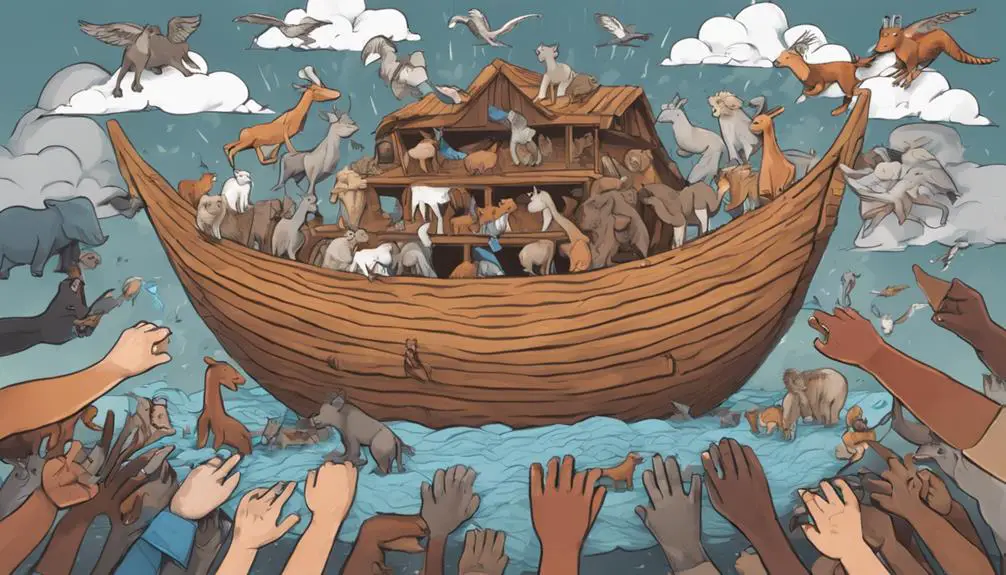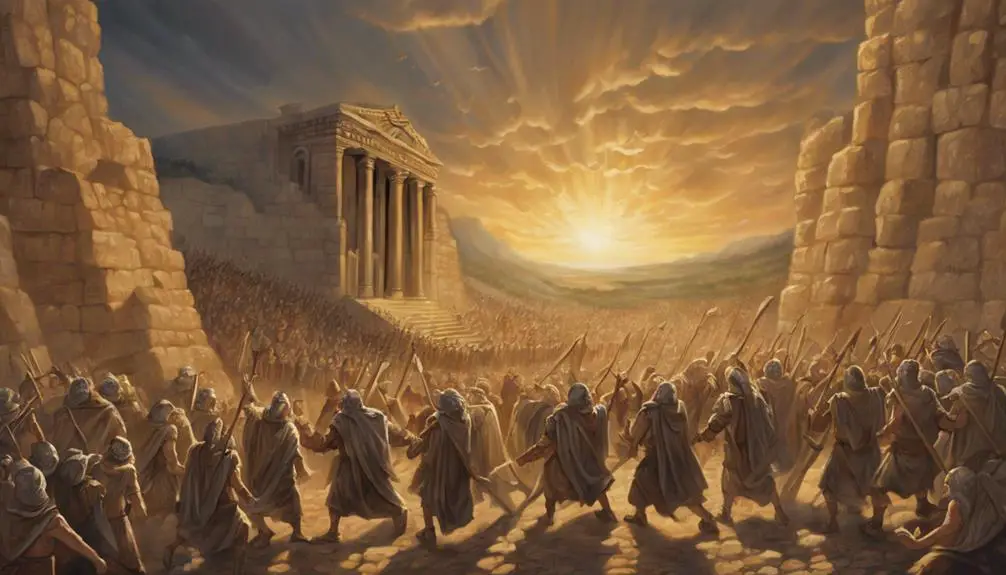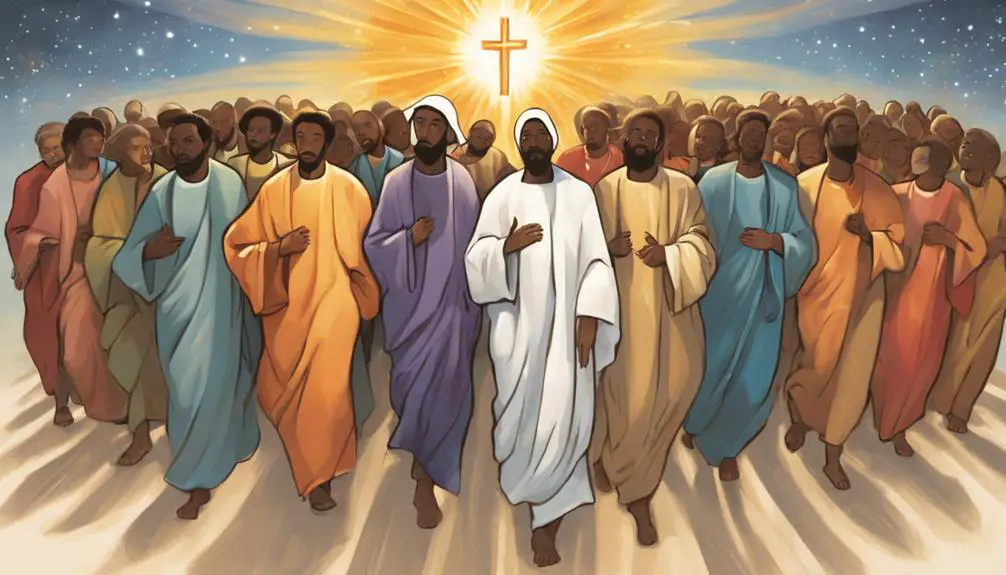Marvel at how biblical tales of teamwork reveal the enduring power of unity, enticing you to uncover the secrets within.

Stories About Teamwork in the Bible
In the tapestry of biblical narratives, threads of teamwork are woven tightly, revealing the power of collective effort in achieving divine purposes. You'll uncover how Noah's family came together to build an ark amidst naysayers, the walls of Jericho tumbled down through unified faith and action, and Moses led a nation to freedom with the support of his brother Aaron and sister Miriam.
Each story, from Nehemiah's communal wall reconstruction to the Apostles spreading the Gospel, showcases the strength found in unity. These tales not only offer historical insights but also serve as timeless reminders of the importance of working together towards a common goal.
Why, you might ask, should these ancient stories matter to you today? Well, the answer lies in the lessons they impart about overcoming challenges through teamwork, lessons that remain as relevant now as they were thousands of years ago.
Key Takeaways
- Biblical stories demonstrate that teamwork is essential to accomplishing divine missions and overcoming challenges.
- Shared vision and mutual support are foundational principles of effective collaboration in biblical narratives.
- Miraculous events in the Bible highlight the power of collective faith and teamwork in achieving extraordinary outcomes.
- No contribution is too small in teamwork, emphasizing the importance of every individual's effort in achieving a common goal.
Building Noah's Ark

In analyzing the construction of Noah's Ark, it's evident that this biblical narrative exemplifies the essence of teamwork, as Noah and his family embarked on the monumental task of building an ark under divine command. You're drawn into a story where the collective effort of a family is pivotal. The narrative isn't just about obedience to a divine command; it's a profound exploration of how individuals come together, pooling their skills and labor towards a common goal. The divine blueprint provided to Noah isn't merely a set of construction plans; it's a symbol of trust and collaboration between the divine and the human.
The gathering of animals, a task that might seem insurmountable, further underscores the theme of cooperation. It's not just about the physical act of bringing the animals to the ark, but also the understanding and harmony needed to manage such a diverse collection of creatures. This aspect of the story highlights the importance of unity and purpose, qualities essential for effective teamwork.
Moreover, the narrative offers a scholarly lens through which to view the concept of teamwork beyond mere human collaboration. It extends the idea to include working in tandem with a divine plan, suggesting that the most effective teamwork comes from aligning human efforts with higher purposes. The construction of Noah's Ark, through its challenges and triumphs, serves as a timeless example of how teamwork, underpinned by a shared vision and divine guidance, can achieve the extraordinary.
The Fall of Jericho

Shifting our focus from the construction of Noah's Ark, we encounter another profound biblical narrative of teamwork: the fall of Jericho, where collective faith and obedience played a crucial role. This episode, far more than a mere historical account, serves as a testament to the interplay between divine intervention and human cooperation within a military strategy framework. The Israelites, under Joshua's leadership, faced the daunting task of capturing a fortified city. Yet, it wasn't sheer military might or tactical prowess that led to their victory but adherence to an unconventional strategy dictated by God.
The plan required the Israelites to march around the city once for six days and seven times on the seventh day, followed by a collective shout. This approach, devoid of any conventional military strategy, underscores the importance of unity and faith in achieving what seems impossible. The walls of Jericho didn't fall because of an assault by siege engines or a tactical breakthrough but collapsed through the power of collective obedience to divine will.
Analyzing the fall of Jericho, we observe a dual focus on divine intervention and the power of collective action. This story emphasizes that success, especially against overwhelming odds, often demands more than individual effort; it requires a unified belief in a higher purpose and strict adherence to collective directives, however unconventional they may seem. The narrative invites reflection on contemporary challenges, suggesting that at times, the key to overcoming formidable obstacles lies in unity, faith, and the readiness to embrace non-traditional solutions.
Moses and the Exodus

The story of Moses leading the Exodus represents a pivotal moment in biblical history, showcasing the profound impact of visionary leadership and collective resolve on achieving liberation against formidable odds. Central to this narrative is the series of plague negotiations Moses enters with Pharaoh, an endeavor that underscores the strategic interplay between divine will and human agency. Each plague, progressively more severe, not only softens Pharaoh's resolve but also galvanizes the Israelites, fostering a sense of unity and purpose among them. This unity is pivotal as it culminates in their departure from Egypt, an act of defiance and faith.
The crossing of the Red Sea is another testament to the remarkable teamwork that defines this story. Faced with the seemingly insurmountable obstacle of the Red Sea and the advancing Egyptian army, the Israelites' faith in Moses' leadership and in the divine promise is put to the ultimate test. The parting of the Red Sea, therefore, isn't merely a miraculous event but a decisive moment of collective faith and action. It underscores the idea that liberation, while divinely ordained, requires human collaboration and faith.
Analyzing the Exodus through the lens of teamwork and leadership offers a nuanced understanding of its significance. It wasn't Moses' leadership alone but the collective will and action of the Israelites, guided by faith and perseverance, that turned the tide against oppression. This story, thus, serves as a powerful example of how visionary leadership, when coupled with collective resolve, can overcome even the most daunting challenges.
Nehemiah Rebuilds the Wall

Just as the Exodus story highlights the power of collective action and faith in overcoming obstacles, Nehemiah's endeavor to rebuild the wall of Jerusalem offers another compelling narrative on the significance of teamwork in achieving monumental tasks. This story, deeply embedded in the fabric of Biblical history, showcases not just the physical rebuilding of a wall but a profound reconstruction of community resilience and leadership skills. Nehemiah's role transcends that of a mere builder; he embodies the quintessential leader, harnessing the collective strength and spirit of his people.
Here are four key elements from Nehemiah's story that underscore the essence of teamwork:
- Vision and Communication: Nehemiah's clear vision and effective communication galvanized the people of Jerusalem. His ability to articulate the importance of their mission fostered a shared sense of purpose.
- Division of Labor: The project's success was largely due to strategic division of labor. Families took responsibility for specific sections of the wall, optimizing the community's effort and resources.
- Leadership Skills: Nehemiah's leadership was pivotal. He not only motivated the community but also implemented strategies to counter external threats, ensuring the project's uninterrupted progress.
- Community Resilience: The communal spirit exhibited by the people, in the face of adversity, underscores the narrative's emphasis on community resilience. Their collective action and mutual support were instrumental in overcoming challenges.
Nehemiah's story is a testament to the power of teamwork, led by visionary leadership and fueled by a resilient community, in transforming daunting tasks into remarkable achievements.
The Apostles Spread the Gospel

In examining the early Christian movement, one can't overlook the pivotal role played by the Apostles in spreading the Gospel, a task that epitomized the essence of collaborative mission work. Following the crucifixion and resurrection of Jesus, the Apostles faced the daunting challenge of disseminating His teachings throughout a diverse and often hostile world. The account of Pentecost, as described in the Acts of the Apostles, marks a seminal moment of Pentecost unity, where the Holy Spirit empowered these individuals, transcending linguistic and cultural barriers, thereby catalyzing the spread of Christianity.
The Apostolic journeys, as chronicled in the New Testament, further illustrate the depth of their collaborative efforts. These weren't solitary ventures; rather, they embodied a collective endeavor, with various Apostles traversing different regions, from Jerusalem to Rome, to share the message of Jesus. These journeys were fraught with difficulties, including persecution, shipwrecks, and imprisonment. Yet, the Apostles' unwavering commitment to their mission, supported by a network of early Christian communities, underscores the power of teamwork in the face of adversity.
Analyzing these endeavors, one observes a model of effective collaboration, where shared vision, mutual support, and resilience in the face of challenges were paramount. The Apostolic journeys weren't merely physical travels but a manifestation of the collective will to fulfill a divine commission. This period in Christian history serves as a compelling testament to the impact of united efforts in spreading transformative messages, a lesson that resonates across ages.
Feeding the Five Thousand

Among Jesus' most emblematic miracles, the feeding of the five thousand stands as a profound demonstration of teamwork's spiritual and practical dimensions. This event, found in all four Gospels, offers a rich tapestry for exploring the dynamics of miracle understanding and resource management within a collective effort.
Here's a breakdown of key elements:
- Initial Assessment: The disciples' first reaction to the large, hungry crowd was to suggest sending them away. Jesus, however, saw an opportunity for a lesson in resource management and faith. He asked, 'What do you have?' prompting them to inventory their available resources, however meager.
- Resource Contribution: The disciples contributed five loaves and two fish, an insignificant amount for such a large crowd. This act underscores the principle that in teamwork, no contribution is too small, and the collective pooling of resources, even if seemingly insufficient, is foundational.
- Miraculous Multiplication: Jesus' blessing and breaking of the bread demonstrate the miraculous potential when faith and action coalesce. This aspect of the narrative highlights that in teamwork, especially within a spiritual context, the sum can exceed the parts through divine intervention or the amplification of effort.
- Distribution and Collection: The disciples played a critical role in distributing the food and collecting the leftovers, evidencing the importance of organization and roles within teamwork. Efficient resource management was showcased as they gathered twelve baskets of leftovers, ensuring nothing was wasted.
Through this analysis, it's evident that the feeding of the five thousand isn't just a story about a miracle but a case study in effective teamwork, resource management, and the power of collective faith and action.
Frequently Asked Questions
How Do Modern Interpretations of These Biblical Teamwork Stories Influence Contemporary Business Leadership Models?
Modern interpretations of biblical teamwork narratives have profoundly shaped contemporary business leadership models. By analyzing these stories within their historical context, you can understand how the underlying principles of collaboration and collective effort have been integrated into today's leadership structures.
These interpretations encourage leaders to foster environments where teamwork is paramount, reflecting a scholarly and analytical approach that bridges ancient wisdom with modern organizational practices.
What Psychological Theories Can Be Applied to Understand the Group Dynamics and Leadership Styles Depicted in These Biblical Stories?
You can apply several psychological theories to understand group dynamics and leadership styles. Group cohesion theory explores how strong ties among group members impact performance. It suggests that a united group can overcome challenges more effectively.
Conflict resolution theory delves into how groups navigate disagreements, aiming for solutions that benefit the collective. Analyzing these theories provides insights into effective leadership and teamwork strategies, essential for thriving in any collaborative environment.
In What Ways Have These Stories About Teamwork Been Adapted or Referenced in Popular Culture, Such as Movies, Literature, or Music?
You're on the brink of discovering how tales of unity have left their mark beyond ancient texts. Through cultural analysis, delve into the realm where artistic inspiration breathes life into movies, literature, and music.
These adaptations not only entertain but serve as a scholarly bridge connecting past to present, embedding age-old values in contemporary narratives.
It's a contextual exploration of how teamwork's essence influences and reshapes modern storytelling.
How Do Non-Christian Religions or Secular Perspectives Interpret the Themes of Teamwork and Collaboration Found in These Biblical Narratives?
You'll find that interfaith interpretations and secular parallels often draw from the universal values of teamwork and collaboration. Scholars suggest these themes resonate across cultures, emphasizing human connection beyond religious boundaries.
In secular contexts, the emphasis might shift to humanist principles, highlighting collective effort and mutual support. Interfaith dialogues, meanwhile, explore commonalities in teamwork narratives, fostering understanding and cooperation between diverse religious traditions.
This analytical perspective underscores the universal appeal of collaboration.
What Are the Implications of These Biblical Teamwork Stories for Interfaith Dialogue and Cooperation in Today's Globalized World?
You're exploring how to foster interfaith dialogue and cooperation in our globalized world. It's crucial to apply cultural sensitivity and ecumenical strategies, drawing lessons from various traditions.
Conclusion
In the tapestry of biblical narratives, teamwork emerges not as a mere thread but as a vibrant, binding force. Through the construction of the Ark, the tumbling walls of Jericho, Moses' leadership, Nehemiah's restoration, the apostles' evangelistic fervor, and the miraculous provision for thousands, you're reminded that collective endeavor is divine.
These stories offer a profound lesson: in unity, there's an unparalleled strength that can weather storms, topple giants, and illuminate the darkest valleys with hope's unyielding light.



Sign up